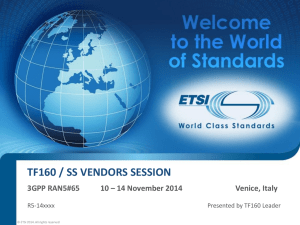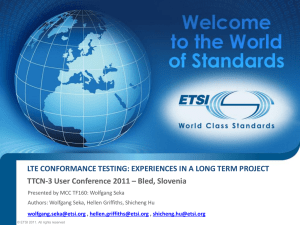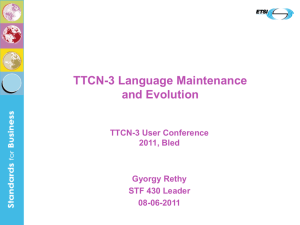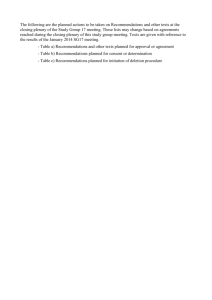About ETSI
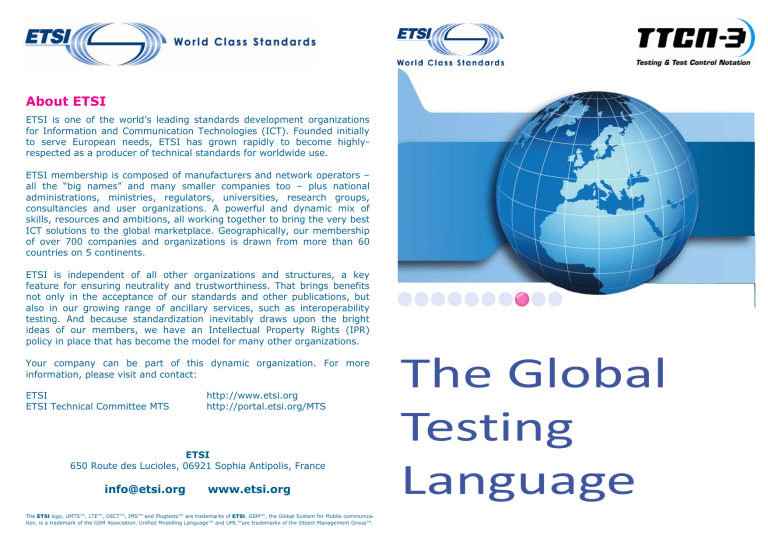
About ETSI
ETSI is one of the world’s leading standards development organizations for Information and Communication Technologies (ICT). Founded initially to serve European needs, ETSI has grown rapidly to become highlyrespected as a producer of technical standards for worldwide use.
ETSI membership is composed of manufacturers and network operators – all the “big names” and many smaller companies too – plus national administrations, ministries, regulators, universities, research groups, consultancies and user organizations. A powerful and dynamic mix of skills, resources and ambitions, all working together to bring the very best
ICT solutions to the global marketplace. Geographically, our membership of over 700 companies and organizations is drawn from more than 60 countries on 5 continents.
ETSI is independent of all other organizations and structures, a key feature for ensuring neutrality and trustworthiness. That brings benefits not only in the acceptance of our standards and other publications, but also in our growing range of ancillary services, such as interoperability testing. And because standardization inevitably draws upon the bright ideas of our members, we have an Intellectual Property Rights (IPR) policy in place that has become the model for many other organizations.
Your company can be part of this dynamic organization. For more information, please visit and contact:
ETSI
ETSI Technical Committee MTS http://www.etsi.org http://portal.etsi.org/MTS
ETSI
650 Route des Lucioles, 06921 Sophia Antipolis, France
info@etsi.org www.etsi.org
The ETSI logo, UMTS™, LTE™, DECT™, IMS™ and Plugtests™ are trademarks of ETSI . GSM™, the Global System for Mobile communication, is a trademark of the GSM Association. Unified Modelling Language™ and UML™are trademarks of the Object Management Group™.
The
Global
Testing
Language
TTCN-3, the global testing language
The Testing and Test Control Notation version 3 (TTCN-3) is a well established mature testing technology. First published in 2000, the flexibility and adaptability of this internationally standardized language has led to its rapid deployment in the telecommunications domain and beyond, including automotive, transportation,
Internet, medical, web-based services, finance, industrial automation, and distributed systems. In addition, its use has expanded from functional conformance testing to include load, performance, and interoperability testing.
TTCN-3 is a multi part ETSI Standard (ES 201 873 series) also published as an ITU-
T Recommendation (Z.140 series). In addition, TTCN-3 extension standards have been developed in the ES 202 78x series for new types of applications. All TTCN-3 standards are owned and continuously maintained and developed by ETSI Technical
Committee Methods for Testing and Specification (TC MTS).
The language has been specifically designed for expressing tests (test scripts) independent of the actual test platform used. It allows users to concentrate on the aspects of what and how they want to test rather than having to focus on low-level implementation details such as encoding of data. The well-defined syntax and operational semantics of TTCN-3 allow a universal and common understanding of the meaning of the tests that it is used to d e s c ri b e. T T C N- 3 h as po w e rf ul programming constructs specific to testing such as the creation of dynamic test c o n f i g u ra ti o n s , s y nc h r o n ou s a n d asynchronous communication mechanisms, data matching templates and mechanisms, built-in verdict assignment etc.
The TTCN-3 Runtime Interface (TRI) and the TTCN-3 Control Interface (TCI) interfaces allow common implementation solutions towards the equipment under test and towards the user in Java, C, C++, and .NET. The benefits of this approach are demonstrated by the wide range of
TTCN-3 tools now available. TTCN-3 also interfaces to other languages such as XML,
ASN.1 and IDL.
ETSI invites everyone to join its open TTCN-3 mailing list by simply sending a message to listserv@list.etsi.org with the body “Subscribe TTCN3”.
The Annual International TTCN-3
User Conference (T3UC)
Since 2004 ETSI has been organizing yearly user conferences that bring together testing experts and engineers from industry, research, and academia as well as invited speakers to see how the language is used in both industrial and research environments in refereed tutorials and presentations, to hear about future directions, to see the latest tools and to share experiences. An archive of all past
T T C N - 3 u s e r c o n f e r e n c e p r e s e n t a t i o n s c a n b e f o u n d a t : http://www.ttcn-3.org/UCArchives.htm.
TTCN-3 User Conferences including guidelines and deadlines for submissions are announced via ETSI’s official TTCN-3 web site www.ttcn-3.org . Each conference located in a different location and arranged together with a key industrial player from the TTCN-3 community. Conferences have been hosted so far in France,
Germany, Sweden, Spain, China and India.
List of ETSI TTCN-3 standards
ES 201 873-1
ES 201 873-3
ES 201 873-4
ES 201 873-5
ES 201 873-6
ES 201 873-7
ES 201 873-8
ES 201 873-9
TTCN-3: Core Language
TTCN-3: Graphical Presentation Format
TTCN-3: Operational Semantics
TTCN-3: TTCN-3 Runtime Interface
TTCN-3: TTCN-3 Control Interface
TTCN-3: The use of ASN.1
TTCN-3: The IDL to TTCN-3 Mapping
TTCN-3: Using XML schema with TTCN-3
ES 201 873-10 TTCN-3: Documentation Comments
ES 202 781 Extension: Configuration & Deployment Support
ES 202 782 Extension: Performance and Real Time Testing
ES 202 784 Extension: Advanced Parameterization
ES 202 785 Extension: Behaviour Types
Users can track the change history of these standards via the links provided at: http://www.ttcn-3.org/StandardSuite.htm www.ttcn-3.org

